After a fabulous breakfast including some coconut noodle pancakes and steamed bananas, we were asking how to replicate the buttery type sauce that seemed to be under the skin of the sliced halves of the bananas. Matthew informed us that the steaming process only worked this well with the right bananas (ie not the tasteless-look-good-for-packing variety we get at home) and no, there was nothing added. Self-saucing bananas!
At 7.30am we flagged down our boat for the three-hour trip to Kottayam. The same beautiful lazy scenery passed us by and we enjoyed the natural air conditioning.  Half way to our destination we stopped at a small riverside shack that served as a small restaurant where we could try some of the local toddy. The proprietors were out the front, down the steps to the river, busy hacking up some medium sized fish with their dog avidly waiting for some tit bits. Already they had some massive crustaceans on a plate. They told us they were prawns, but they were the size of yabbies or Balmain Bugs. Apart from their prawn-like bodies, they had monstrous blue tentacle-feelers that were twice their body length. Not something I’d want to swim with.
Half way to our destination we stopped at a small riverside shack that served as a small restaurant where we could try some of the local toddy. The proprietors were out the front, down the steps to the river, busy hacking up some medium sized fish with their dog avidly waiting for some tit bits. Already they had some massive crustaceans on a plate. They told us they were prawns, but they were the size of yabbies or Balmain Bugs. Apart from their prawn-like bodies, they had monstrous blue tentacle-feelers that were twice their body length. Not something I’d want to swim with.
The toddy came out in a recycled water bottle and was a beige cloudy liquid. Toddy is made from the sap of the non-fruiting palm tree and it can be consumed fresh or fully fermented. Ours was somewhere in between and contained about 2% alcohol. The catch with drinking it however, was that it positively reeked. If you could get past that, it had a slightly sweet flavour and the fizz of homemade ginger beer.
The rest of the journey was a bit more eventful as we had to pass under three bridges. Of varying size and stability and weighed down with boulders, they were raised manually by bridge keepers to allow us to pass through. We were still passing a succession of washing-whackers and there were plenty of children heading off to school to wave us on our way.
Two Toyota Qualis were waiting for us when we disembarked so I quickly sped off to get some water for the trip. A two-litre bottle was offered to me for 20RS. Spying the fridge at the back of the shop, I asked for cold. ‘Two rupees extra,’ said the shopkeeper. Instead of just saying okay, I wobbled my head in acceptance and handed over the extra coins. Cripes. I will have to be vigilant on my return home if I don’t want to be a laughing stock…
Kottayam is quite a busy town and was the first in India to achieve full literacy (coincidentally too, Arundhati Roy grew up near here). As we drove through the town I noted several instances of red vertical banners or flags with white hammer-and-sickle motifs fluttering in the breeze. A good communist stronghold as well, it would appear.
It is a 112 km journey to Thekkady (the administrative town centre for Periyar National Park) and the windy road will take us from sea level to the heights of the blue Nilgiri Hills.
This area is highly fertile and there was something interesting to see around every corner. Red, green and yellow bananas hanging in large bunches at roadside stalls; trucks full of pineapples; oranges, both black and white grapes; with a common sight being the different coloured fruit arranged in geometrical patterns in sloping shelves.
We then entered rubber country. The first sign of this was the rubber bathmats draped over lines like so much washing. When we stopped at a plantation to investigate, we were shown all the steps in the process.
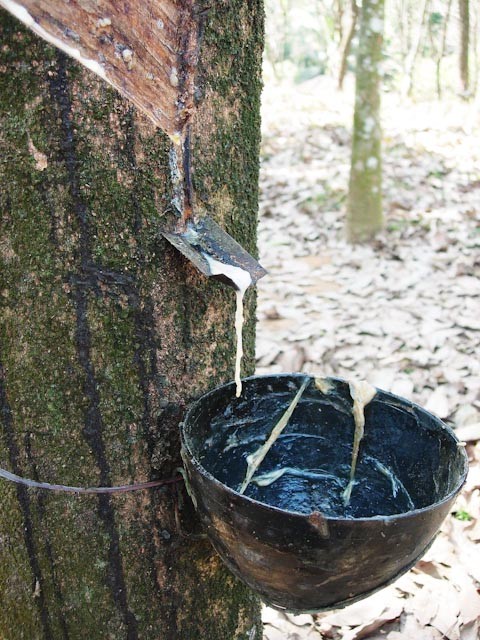
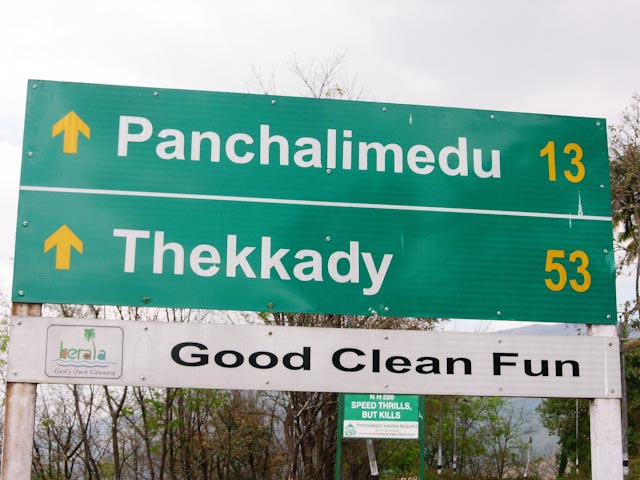
Orderly lines of rubber trees with their incisions and attached small bowls collect 25kg of rubber per tree per annum. One section will be used for incisions until it gets to about 20cm squared – this takes about seven years – then the cuts are made elsewhere and the tree is allowed to heal itself. The raw rubber is then pressed in a mangle that creates the bathmats we had already seen. These flaps are then placed in a smokehouse to cure. They come out coloured the translucent brown of Pear’s soap, and obviously reeking of smoke.
As we increased altitude the crops around us changed. Some more hairpin turns brought us into cocoa tree plantations, then high on the hillside were long-leaved bushes ready for pineapples to sprout up in the centre. Some fields had the pineapples interspersed with sapling rubber trees, fully utilising the land. The air was becoming perceptibly cooler but remained humid. I was really looking forward to be able to wear a jumper in the evening.
Plantain banana plantations passed us by and our driver pointed out pepper vines creeping up trees with their little bunches of green berries. We also observed several houses where there were piles of black peppercorns lying out on plastic sheets drying in the sun.
Still higher came the coffee plants covered in red berries, followed by neat clumps of tea bushes, glossy green and all trimmed to an equal height to ease the job of the picker. The hillside was covered in crazy mazed patterns formed by the rippled paths between the bushes.
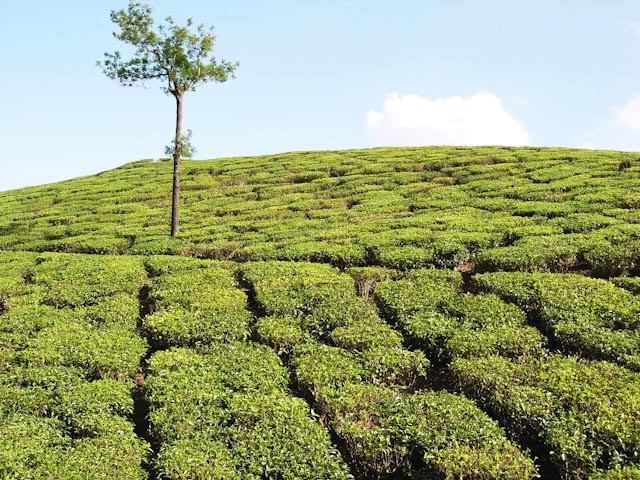
Eight kilometres outside Periyar we pulled up outside Abraham’s Spice Garden, which has enjoyed international TV coverage. Mr Abraham is a genial handsome man of about 60 with springy grey curls and the most marvellous tufts of black hair protruding out of his ears – clearly his growing skills are not limited to his green thumb.
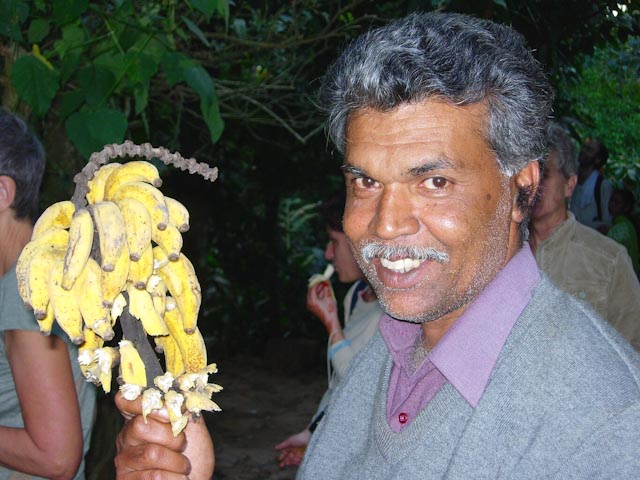 Our tour started at the front gate and progressed plant by plant. The first tree we were shown had tiny little bunches of green buds. These are picked before they have a chance to flower and once dried, they are cloves. Near the base of this tree he dug up a yellow root – turmeric. Mr Abraham explained its food usage but also its medicinal value. ‘There have been studies done in the US that have shown that turmeric inhibits colon cancer.’ There were also two other types in his garden, one white and the other cream. One of these is used as a constituent in some anti-ageing cosmetics. Nearby he unearthed another root, ginger this time.
Our tour started at the front gate and progressed plant by plant. The first tree we were shown had tiny little bunches of green buds. These are picked before they have a chance to flower and once dried, they are cloves. Near the base of this tree he dug up a yellow root – turmeric. Mr Abraham explained its food usage but also its medicinal value. ‘There have been studies done in the US that have shown that turmeric inhibits colon cancer.’ There were also two other types in his garden, one white and the other cream. One of these is used as a constituent in some anti-ageing cosmetics. Nearby he unearthed another root, ginger this time.
We saw male and female nutmeg trees (fruit only grows on the female) and this fruit is also the source of mace, which is the red skin surround the nutmeg nut. Cinnamon bark was sliced off for our sniffing, pepper vines were pointed out with their hanging green fruit (Ray took a nibble of some of these and regretted it), and we saw pineapple plants and vanilla pods that looked like string beans hanging from a vine.
‘We have to manually pollinate the vanilla plant,’ Mr Abraham told us, ‘as the bee that used to do this job has become extinct.’
We saw rose apples and we got to sample skinny little lady’s finger bananas as well as some other varieties, which were all incredibly sweet.
We made a right mess of ourselves delving our fingers into a delicious mushy custard apple. As we were instructed to spit the seeds into the garden, I hope Mr Abraham won't mind growing a few more of these trees.
There were tomato-shaped eggplants and long thin elongated varieties (the variety from the home stay apparently being a rarity). There were bulbous jackfruit, crushed curry leaves to be whiffed and the leaves ‘five spices’ are made from were pointed out and duly crushed and sniffed. I had thought it was simply a mix of five different spices – there you go.
We saw the massive green pods of the cocoa plant that contain those wonderful little beans that eventually lead to chocolate and near this tree hung a solitary massive lemon. Up in the back garden we were shown several varieties of coffee berries, Arabica and Robusta among them. I squeezed one of the berries and out shot one of the beans like a bullet. Each berry has two beans so I carefully extracted the other one. A perfectly formed white bean, wet and extremely slippery with the berry’s innards.
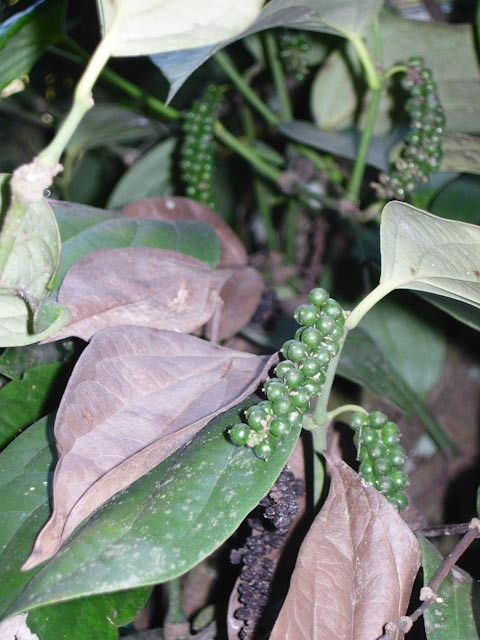
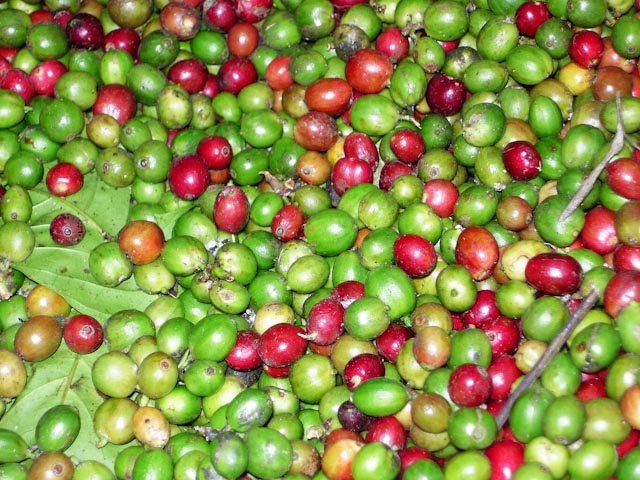
Mr Abraham took us up onto his roof where we saw piles of these berries drying out prior to the roasting process commencing.
The discovery tour didn’t stop in the garden either. Mr Abraham and his wife were putting on a dinner for us so that we could sample some of the finished products firsthand. Literally, as we would be eating with our hands Indian-style, off soft glossy banana leaves.
Bowls of cassava (used for making tapioca) came out first, followed by a potato curry flavoured with cumin. Jugs of cumin-flavoured water were placed at each end of the table for drinking, followed by fish and chicken dishes, fat rice, pappadums, a carrot and cabbage mixture and a stack of appam, a rubbery rice pancake.
Mr Abraham instructed us in the art of eating elegantly with our fingers.
‘Put the wet curry on the rice and mix and pinch with your fingers. Now turn your hand upside down once you have a pinch-full and move your thumb to be behind the food. The thumb is then used to push the food off your fingers into your mouth.’ Easy. To think I’ve had the tools for this all along and never used them properly.
We were then told to push our leavings onto the back half of the banana leaf to make space for dessert. The steps for making ‘banana mash’ were then dictated to us.
‘Pile up some fat rice and squash your lady’s finger banana over the rice, like so. Now ladle some curd (yoghurt) over the top and sprinkle sugar to taste. Now mix it all up into a mash.’ Splendiferous. And guess what? No washing up.

Comments
Total Comments : ( ) You have to register to post a comment.
RECENT COMMENTS